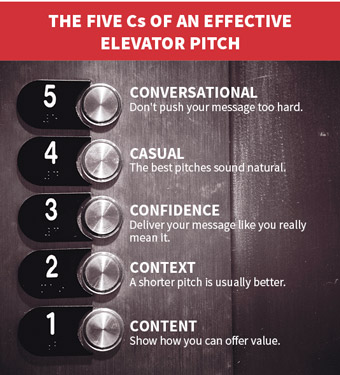The Elevator Pitch
How to leave a lasting impression and take your networking game to the next level
February/March 2018Many find it challenging to develop an effective elevator pitch. In fact, when I’ve asked experienced business professionals at networking events what percentage of the pitches they just heard were particularly engaging and effective, the answer I typically get is 10 percent.
Why is this? The biggest reason is that most people think their pitch should be about providing information. Nothing could be further from the truth.
The real goal of your elevator pitch should be very simple: to leave listeners wanting to know more. I know I’ve reached my goal when people ask me questions afterward. That means they are engaged and want to know more.
The more information you include in your pitch, the less room there is for people to ask questions. When you tell them exactly what you do, they simply file your pitch away for future use—“I know what that person does, and if I ever need that, I’ll reach out.” But the odds that they actually reach out are low because you haven’t left a memorable impression.
Now, you may get lucky and someone really wants an expert in your specific area right now, so that sparks a conversation. But that doesn’t mean your pitch was effective. You would have achieved the same result if you had an interesting and engaging pitch, and you might have had many others interested in talking with you as well.
Now let’s break it down further.
Crafting the Content of Your Elevator Pitch
Suppose I’m at the networking reception at a Society of Actuaries (SOA) conference, and someone asks me what I do. I say, “I’m an actuary with (insert company name).”
That is what I would call a “title” format. But a title is just that—it’s information that lets someone slot me into a role in their mind. It tells what I do, but not the value I provide in that role. Unless the other person is very interested in actuaries, it doesn’t do much to advance a conversation.
What if instead I responded with, “Most recently, I created an actuarial experience system that allows us to dig deeply into our results and to secure rate actions we previously could not have hoped to get approved.” Now I’ve provided an interesting response that suggests value I bring to the table.
The person interested in actuaries will still know I do actuarial-related work, and may even be more interested in talking to me because of the result I produced. And others may be interested because they work with experience analysis, rate actions or state filings, or simply want to know what else I may be capable of doing. The bottom line is that I’ve said something more interesting!
Notice that I didn’t include a title in this second answer. I didn’t even say that I’m an actuary.
That’s purposeful. The title tends to dilute the effect of the results-based statement. If I modified the statement with, “I’m an actuary with … and most recently …” it wouldn’t be as strong. As soon as listeners heard the title, they would mentally “slot” me in their files, and they wouldn’t listen as carefully to the rest of the statement. And whatever mental baggage (good or bad) they associate with the title actuary would have just been assigned to me.
On the other hand, if they are first engaged by an example of the value I can bring to the table, and then later in the conversation ask about my job, there is a different reaction. Now they are asking because they are truly interested in what I do, and when I tell them I’m an actuary, instead of just assigning that baggage, their mental reaction may be, “He’s not like other actuaries I’ve met!”

Now, obviously that simple one-line response to “What do you do?” does not fill up the 20–30 seconds that make up the average elevator pitch. Think of it as a building block to start you on your way. Now you can flesh it out further to make up your full pitch.
Here’s one way I might expand on this example to create a more complete elevator pitch: Our company was struggling to keep its disability line profitable, so I put together a small task force to gather data from thousands of paper applications, built a data repository and designed an actuarial experience system that allows us to dig deeply into our results. We’re now able to secure rate actions that we previously could not have hoped to get approved, and have even secured funding from our parent to expand the system. I’m John Hadley, and I make actuarial operations more efficient.
Whether I would include my name at the start or the end of the pitch depends on how the group approaches me. If I’m introduced with my name, then I’ll save it for the end (as shown in the example). If not, I’ll start with my name. But either way, best practice is to always end with your name—if you’ve engaged people with your pitch, that’s the time they will focus and potentially remember it!
Of course, there are other elements to consider beyond the words themselves. Here are what I call the five Cs of an effective elevator pitch:
- Content
- Context
- Confidence
- Casual
- Conversational
We’ve already talked about the content; now let’s take a look at the other four Cs.
Context
Don’t forget where and how you are making your pitch:
- A venue where everyone is expected to get up in turn to give an elevator pitch is very different from a one-on-one conversation.
- The same pitch that is very effective in response to a question like “What do you do?” may sound stilted or “salesy” as an introduction. You may be more effective breaking it down into shorter segments, and then using those as responses to various questions.
- A pitch to a roomful of actuaries can be more technical than a pitch to a more general audience.
- In almost every context, shorter is better.
I once invited a job seeker to a business networking group where everyone got a chance to stand up and give a 30-second pitch to the group. She used only 15 seconds, and then turned to me disappointed in herself. I told her that her pitch actually stood out because what she said in just 15 seconds was interesting. In fact, after the formal part of the meeting ended, two people came up to her with job leads.
Confidence
If you don’t feel and act confident in your message, why should I give it any credibility? Whatever you are going to say, you must deliver it comfortably, confidently and smiling like you really mean it.
If you need to pause to remember details, feel nervous or find yourself stumbling, cut it down to just one line, followed by your name. Only after you get really good at delivering that short message with panache should you consider adding a second or third line.
Remember that a new message or delivery style may feel uncomfortable, so practice it until you can deliver it with confidence. And if you never achieve that level of confidence, think about starting over with a different message that works for you.
Casual
The best pitch sounds natural.
- Avoid technical jargon and long words that are difficult to understand. Just because you are in front of an audience that may understand the jargon doesn’t mean you will be more effective using it.
- Keep it simple, casual and something you could actually say in a friendly conversation.
- Practice your pitch so that you can call it up naturally in every situation, then throw away the script. It’s more effective if it comes out a little different each time.
- Change it up. Switch the order. Use different “marketing headlines.” This will help keep it natural and not sound “memorized.”
Conversational
I invited a friend whom I considered to be a good networker to join me for a business networking event. I introduced him to someone, and he immediately launched into his 30-second pitch. While the content was sterling, the impression created was that he was trying to sell something.
Don’t work to push your message on others—deliver it conversationally. In a natural conversation, there is give and take. You don’t suddenly jump up on a soapbox and deliver a pitch. Think in terms of communicating the elements of your pitch line by line in response to appropriate questions.
Conclusion
Start with powerful content, and then focus on all of the five Cs. You will be dramatically more effective with your marketing message!

